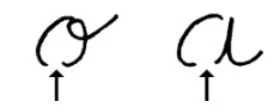Long before AI and digital forensics, experts like Cesare Lombroso believed handwriting held the key to criminal minds. In 1893, he studied over 500 samples and linked heavy, smeary writing — or “pastosity” — to violent tendencies like murder, while lighter, more delicate styles were tied to non-violent crimes such as theft or fraud.
Though later dismissed as overly simplistic by psychologist Alfred Binet in 1906, graphology didn’t disappear. By the 1920s and ’30s, researchers like Crépieux-Jamin and Nock Sylvus shifted focus from “criminal handwriting” to extreme personality traits reflected in writing. In one major study, Dr. Roda Wieser found that poor writing rhythm was a common trait among murderers and serious offenders, suggesting handwriting might still hold psychological clues.
Graphic Indicators of Potential Criminality
Over time, graphologists identified several handwriting features believed to correlate with deceptive or antisocial behavior:
- Ambiguous Numbers
Often found in swindlers’ writing, reflecting a desire to avoid specifics.
- Counterstrokes

Reversed or exaggerated strokes, associated with resistance to norms and amorality.
- Illegibility
Seen in fraudsters who may want to obscure their true intentions.
- Exaggerated Legibility
In some deceivers, overly clear writing is a deliberate disguise.
- Open or Left-Tending Ovals
Often interpreted as signs of dishonesty or manipulation.
Example of Open ovals: Example of left-tending ovals:


- Pastosity
Thick, smeared strokes suggesting emotional instability and impulsive behavior.
- Rolled Strokes
Repetitive loops and curls, typically linked to cunningness and lack of sincerity.

- Slow Writing
Indicates deliberate concealment, often seen in calculated criminals.
Trait Combinations: Building a Criminal Profile
Criminal behavior is complex and multifaceted. Rather than single traits, it is the combination and intensity of various traits that raises red flags. For instance:
- A person with high acquisitiveness, low empathy, and strong material orientation may be predisposed to crimes like embezzlement or forgery.
- Broadmindedness, while typically a virtue, in extreme forms can justify breaking rules or moral codes, potentially leading to crimes like murder.
- Traits like temper, selfishness, and physical orientation often appear in violent offenses such as assault or rape.
Modern Relevance and Ethical Concerns
Despite its historical fascination, graphology remains a controversial tool in criminal psychology. Modern forensic science favors hard evidence over subjective interpretation. Yet, as personality profiling gains popularity through psychological analysis and even trending tools like AI character assessments, interest in graphology is experiencing a revival. Searches related to personality types, narcissism, and criminal psychology have surged, showing the public’s growing curiosity about what drives deviant behavior. Handwriting analysis fits into this broader context of understanding the self and others.
Final Thoughts: Science or Art?
Handwriting analysis may not be able to convict a criminal, but it offers an intriguing lens into the human psyche. When used alongside established psychological methods, it can contribute to a deeper understanding of behavioral patterns.
So next time you pick up a pen, remember: your handwriting might just reveal more than you think.
Handwriting analysis has helped to understand one another in a relationship and make the relationship last. For a better relationship, try to learn handwriting analysis at KAROHS International School of Handwriting Analysis. Visit our website https://karohs.school/product/the-inner-circle-papers/ to see our product and follow our instagram @karohs.school for more information about handwriting analysis.

